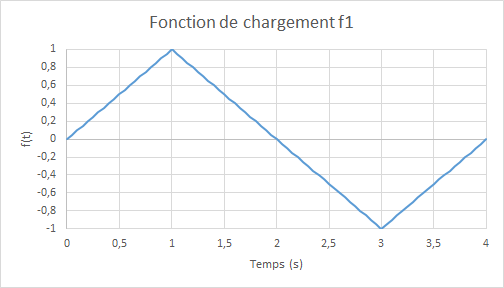8. F modeling#
8.1. Characteristics of modeling#
The loading is of the pure alternating bending type.

Figure 8.1-a : mesh and boundary conditions
Modeling: DKTG
Boundary conditions:
\(\mathrm{DRY}=0.0\) on the \({A}_{1}-{A}_{3}\) ridge
\(\mathrm{DRY}={R}_{0}\times f(t)\) on the \({A}_{2}-{A}_{4}\) edge,
where \({R}_{0}=3.0\times {10}^{-2}\) and \(f(t)\) is the magnitude of the cyclic loading as a function of the (pseudo-time) parameter \(t\).
To verify the model, consider the following loading function:

Figure 8.1-b : loading function
8.2. Characteristics of the mesh#
Number of knots: 9.
Number of stitches: 8 TRIA3; 8 SEG2.
8.3. Tested sizes and results#
The reaction moments along the \(\mathit{Oy}\) axis in \(\mathit{A1}\mathrm{-}\mathit{A3}\) and the rotations along the \(\mathit{Ox}\) en \(\mathit{A4}\) axis obtained by multilayer modeling with the ENDO_ISOT_BETON law and by the one based on the BETON_REGLE_PR law are compared, in terms of relative differences; the tolerances are taken in absolute value:
Identification |
Reference type |
Reference value |
Tolerance |
|
FLEXION POSITIVE - ELASTIQUE \(t=\mathrm{0,25}\) |
||||
Relative difference \(\mathit{MY}\) |
|
1 10-6 |
||
Relative difference \(\mathit{DRX}\) |
|
1 10-6 |
||
FLEXION POSITIVE - ENDOMMAGEMENT \(t=\mathrm{1,0}\) |
||||
Relative difference \(\mathit{MY}\) |
|
1 10-6 |
||
FLEXION POSITIVE - DECHARGEMENT \(t=\mathrm{1,5}\) |
||||
Relative difference \(\mathit{MY}\) |
|
1 10-6 |
||
FLEXION NEGATIVE — ELASTIQUE \(t=\mathrm{2,25}\) |
||||
Relative difference \(\mathit{MY}\) |
|
1 10-6 |
||
FLEXION NEGATIVE - ENDOMMAGEMENT \(t=\mathrm{3,0}\) |
||||
Relative difference \(\mathit{MY}\) |
|
1 10-6 |
||
FLEXION NEGATIVE - **** DECHARGEMENT ** \(t=\mathrm{3,5}\) |
||||
Relative difference \(\mathit{MY}\) |
|
1 10-6 |
Comparative moment graphs \(\mathrm{MY}\) — rotation \(\mathrm{DRY}\) in alternating flexure for load \(f\) :: **

Comparative rotation graphs \(\mathit{DRX}\) (due to the Poisson effect) as a function of time:

8.4. notes#
The test case carried out here aims to test model BETON_REGLE_PRsous stresses that are significant enough for steels to effectively recover their stiffness.
The behavior is similar in bending for the laws BETON_REGLE_PRet ENDO_ISOT_BETON under load: the differences appear for large loads due to the difference in behavior under compression.
The landfill response is not taken into account by law BETON_REGLE_PR (elastic response).
We observe a symmetry of the response for law BETON_REGLE_PR.
The \(\mathrm{DRX}\) rotation is zero with the BETON_REGLE_PR law because the Poisson effect is not taken into account.